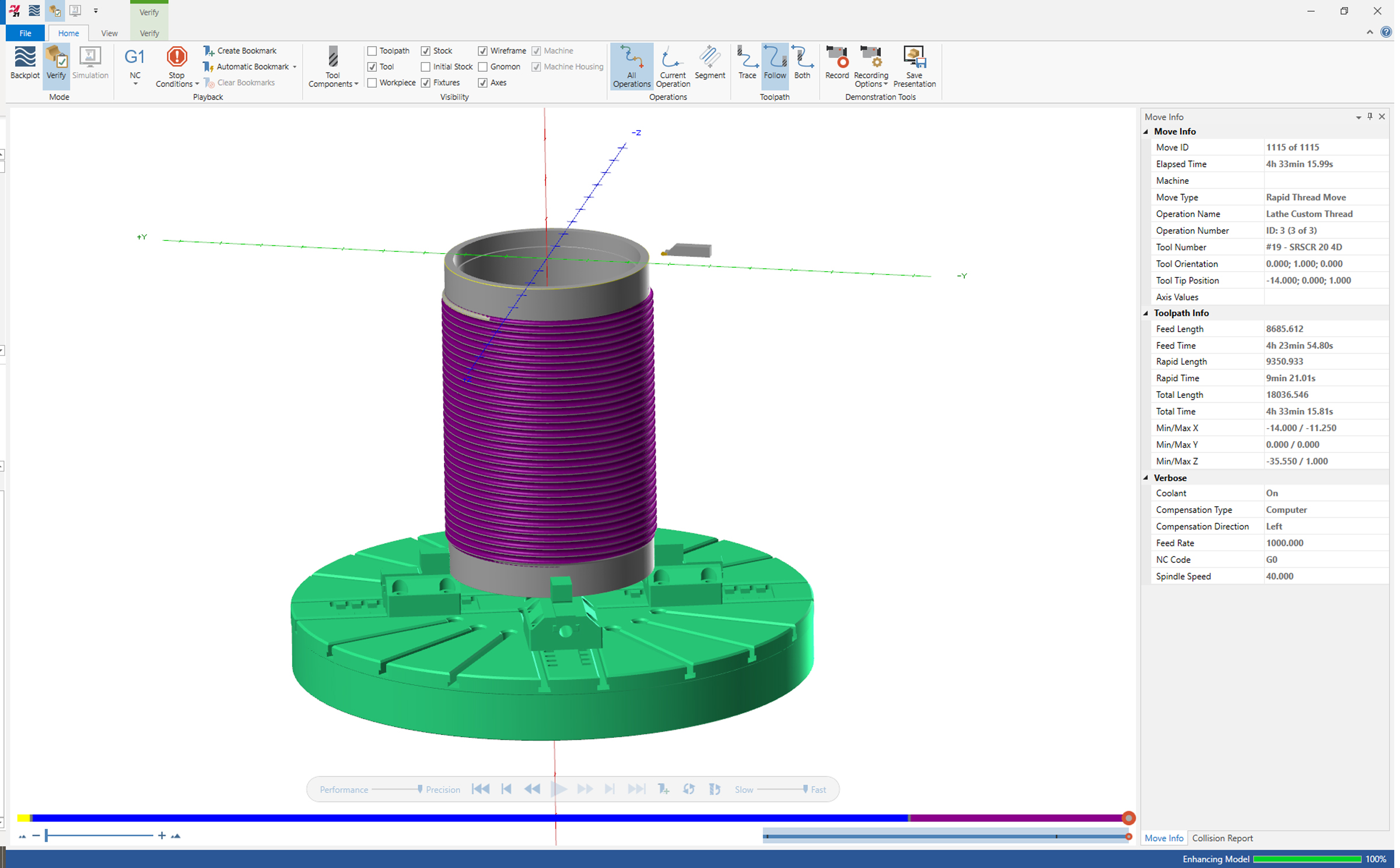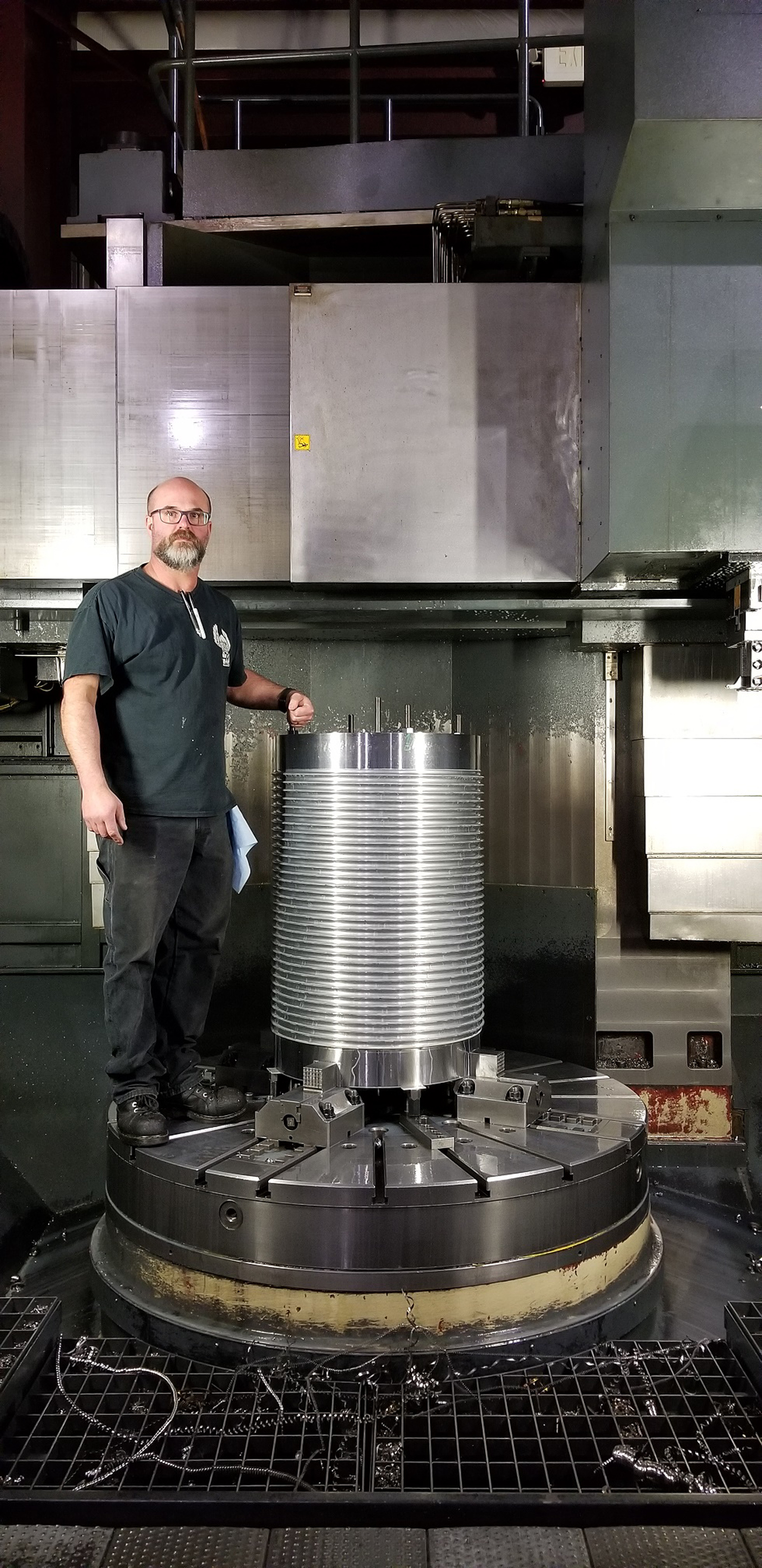Sam Roberts has more than two decades of experience in programming and manual and CNC operations, but still  remembers the day in 1999 when he was introduced to Mastercam CAD/CAM software (CNC Software Inc., Tolland, Connecticut). As a machinist proficient in G-code, Roberts was impressed with the software.
remembers the day in 1999 when he was introduced to Mastercam CAD/CAM software (CNC Software Inc., Tolland, Connecticut). As a machinist proficient in G-code, Roberts was impressed with the software.
“I saw Mastercam and had an opportunity to see what it could do,” he said, thinking. “That’s a lot better than typing in G-code all day.”
In 2001, Roberts seized an opportunity to run his own machine shop. Armed with Mastercam Version 6 and a Haas VF-3 vertical machining center, he launched 3D-Machine Inc. Located 25 miles northwest of Atlanta in Powder Springs, GA, the full-service machine shop specializes in precision milling and turning of parts ranging from less than 1 oz to 30,000 lbs. Industries served include hydro and nuclear power, automotive, aerospace, communications, and medical.
 Over the past 20 years, 3D-Machine has grown at a steady clip. Its original 1,200-sq-ft facility expanded to 38,000 sq ft. A larger facility means more employees—23 people are currently employed here—and larger machinery, including a horizontal boring mill, lathes, and vertical turning lathes (VTLs).
Over the past 20 years, 3D-Machine has grown at a steady clip. Its original 1,200-sq-ft facility expanded to 38,000 sq ft. A larger facility means more employees—23 people are currently employed here—and larger machinery, including a horizontal boring mill, lathes, and vertical turning lathes (VTLs).
Roberts relies on the software for his shop’s design and production needs. 3D-Machine stays current in Mastercam capabilities by keeping up with the latest releases, including the newest release that features Mastercam Mill, Mastercam Lathe, Mastercam Wire, and Solids. In addition, the company is participating in the Beta Program for Mastercam 2021. Roberts appreciates the software’s generous selection of toolpaths, including a new toolpath he just discovered called Lathe Custom Thread.
The new toolpath supports custom thread forms and expands support for modeling chucks and chuck jaws. The CAM software supports collet chucks as individual component types, which expands the range of machines that can be directly supported.
By selecting chained geometry in Lathe Custom Thread, a programmer can choose the thread cross-section or one of the following parametric definitions: Rope, Buttress, Square, or Trapezoidal. The toolpath includes Mastercam Mill-Turn simulation enhancements, as well as support for select Swiss machining.
Recently, 3D-Machine produced a carbon steel part for a cable reel. It has a 0.9375” (23.8125 mm) pitch and a 0.406” (10.3124 mm) radius; a 12mm (0.4724”) button tool was used to rough and finish the part.
The part, a hoist drum, employs a wire rope or cable to lift or lower loads. The grooves keep steel cables from overlapping, potentially damaging the cable, and prevent inconsistent lift and lowering of objects. Due to its size, the drum was machined on a large VTL. The selected toolpath is not limited to vertical machining and can just as easily be performed on a horizontal lathe. In this case, the machinist cut a left-hand spiral, so the tool engaged in the cut from the bottom to the top to produce the shape.
“It took us seven hours to put in this groove, which if you laid out in a straight line would measure 212 linear feet,” said Roberts. “We had to use a mill and a rotary to make, rough, then finish the part. We did the deburr on a VTL in seven hours. Because we created the chain, the deburr occurred during the process.”
To ensure that a part’s shape is exactly what they are looking for, Roberts and his team use Verify, a CAM software feature that prevents tool collisions by letting programmers check for gouges, view finished part shapes, and visualize inclusion of fixtures in its simulation screen. Productivity increases and problems are addressed before parts are ever cut.
3D-Machine programmers maintain manufacturer-specific, easy-to-use tool libraries loaded with accurate tool dimensions and data. Importing tool data directly into the CAM program allows for more time at the machine.
“When I create set-up sheets, they include a description of the tool, a tool holder, and required pull-outs,” said Roberts. “If machinists follow those rules on the shop floor based on the pull-outs that we give them, they don’t wreck the holder, they don’t hit clamps, they don’t have any surprises.”
Due to the number of fixtures designed and machined in Mastercam, Roberts and his staff used the software to create a fixture database. They have acquired more than one hundred fixtures so far. Anyone who is producing a part can bring a fixture and their part into the CAM software.
“It’s just a great tool,” said Roberts. “By maintaining a database of all our fixtures, we eliminated repetitive processes that we may have had to perform 20 years ago. Now, we’re not reinventing the wheel every time we take on a new job.”
For more information on CNC Software Inc.'s software and services, visit www.mastercam.com.
Contact Details
Related Glossary Terms
- boring
boring
Enlarging a hole that already has been drilled or cored. Generally, it is an operation of truing the previously drilled hole with a single-point, lathe-type tool. Boring is essentially internal turning, in that usually a single-point cutting tool forms the internal shape. Some tools are available with two cutting edges to balance cutting forces.
- chuck
chuck
Workholding device that affixes to a mill, lathe or drill-press spindle. It holds a tool or workpiece by one end, allowing it to be rotated. May also be fitted to the machine table to hold a workpiece. Two or more adjustable jaws actually hold the tool or part. May be actuated manually, pneumatically, hydraulically or electrically. See collet.
- collet
collet
Flexible-sided device that secures a tool or workpiece. Similar in function to a chuck, but can accommodate only a narrow size range. Typically provides greater gripping force and precision than a chuck. See chuck.
- computer numerical control ( CNC)
computer numerical control ( CNC)
Microprocessor-based controller dedicated to a machine tool that permits the creation or modification of parts. Programmed numerical control activates the machine’s servos and spindle drives and controls the various machining operations. See DNC, direct numerical control; NC, numerical control.
- computer-aided manufacturing ( CAM)
computer-aided manufacturing ( CAM)
Use of computers to control machining and manufacturing processes.
- fixture
fixture
Device, often made in-house, that holds a specific workpiece. See jig; modular fixturing.
- gang cutting ( milling)
gang cutting ( milling)
Machining with several cutters mounted on a single arbor, generally for simultaneous cutting.
- lapping compound( powder)
lapping compound( powder)
Light, abrasive material used for finishing a surface.
- lathe
lathe
Turning machine capable of sawing, milling, grinding, gear-cutting, drilling, reaming, boring, threading, facing, chamfering, grooving, knurling, spinning, parting, necking, taper-cutting, and cam- and eccentric-cutting, as well as step- and straight-turning. Comes in a variety of forms, ranging from manual to semiautomatic to fully automatic, with major types being engine lathes, turning and contouring lathes, turret lathes and numerical-control lathes. The engine lathe consists of a headstock and spindle, tailstock, bed, carriage (complete with apron) and cross slides. Features include gear- (speed) and feed-selector levers, toolpost, compound rest, lead screw and reversing lead screw, threading dial and rapid-traverse lever. Special lathe types include through-the-spindle, camshaft and crankshaft, brake drum and rotor, spinning and gun-barrel machines. Toolroom and bench lathes are used for precision work; the former for tool-and-die work and similar tasks, the latter for small workpieces (instruments, watches), normally without a power feed. Models are typically designated according to their “swing,” or the largest-diameter workpiece that can be rotated; bed length, or the distance between centers; and horsepower generated. See turning machine.
- machining center
machining center
CNC machine tool capable of drilling, reaming, tapping, milling and boring. Normally comes with an automatic toolchanger. See automatic toolchanger.
- milling
milling
Machining operation in which metal or other material is removed by applying power to a rotating cutter. In vertical milling, the cutting tool is mounted vertically on the spindle. In horizontal milling, the cutting tool is mounted horizontally, either directly on the spindle or on an arbor. Horizontal milling is further broken down into conventional milling, where the cutter rotates opposite the direction of feed, or “up” into the workpiece; and climb milling, where the cutter rotates in the direction of feed, or “down” into the workpiece. Milling operations include plane or surface milling, endmilling, facemilling, angle milling, form milling and profiling.
- milling machine ( mill)
milling machine ( mill)
Runs endmills and arbor-mounted milling cutters. Features include a head with a spindle that drives the cutters; a column, knee and table that provide motion in the three Cartesian axes; and a base that supports the components and houses the cutting-fluid pump and reservoir. The work is mounted on the table and fed into the rotating cutter or endmill to accomplish the milling steps; vertical milling machines also feed endmills into the work by means of a spindle-mounted quill. Models range from small manual machines to big bed-type and duplex mills. All take one of three basic forms: vertical, horizontal or convertible horizontal/vertical. Vertical machines may be knee-type (the table is mounted on a knee that can be elevated) or bed-type (the table is securely supported and only moves horizontally). In general, horizontal machines are bigger and more powerful, while vertical machines are lighter but more versatile and easier to set up and operate.
- pitch
pitch
1. On a saw blade, the number of teeth per inch. 2. In threading, the number of threads per inch.
- sawing machine ( saw)
sawing machine ( saw)
Machine designed to use a serrated-tooth blade to cut metal or other material. Comes in a wide variety of styles but takes one of four basic forms: hacksaw (a simple, rugged machine that uses a reciprocating motion to part metal or other material); cold or circular saw (powers a circular blade that cuts structural materials); bandsaw (runs an endless band; the two basic types are cutoff and contour band machines, which cut intricate contours and shapes); and abrasive cutoff saw (similar in appearance to the cold saw, but uses an abrasive disc that rotates at high speeds rather than a blade with serrated teeth).
- toolpath( cutter path)
toolpath( cutter path)
2-D or 3-D path generated by program code or a CAM system and followed by tool when machining a part.
- turning
turning
Workpiece is held in a chuck, mounted on a face plate or secured between centers and rotated while a cutting tool, normally a single-point tool, is fed into it along its periphery or across its end or face. Takes the form of straight turning (cutting along the periphery of the workpiece); taper turning (creating a taper); step turning (turning different-size diameters on the same work); chamfering (beveling an edge or shoulder); facing (cutting on an end); turning threads (usually external but can be internal); roughing (high-volume metal removal); and finishing (final light cuts). Performed on lathes, turning centers, chucking machines, automatic screw machines and similar machines.

